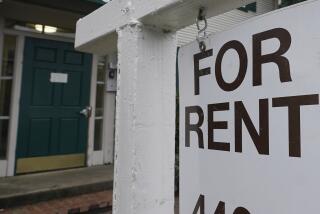SANTA ANA : Suit Filed Against Housing Ordinance
A recently approved city ordinance that calls for fining or jailing of residents and landlords whose homes are overcrowded is illegal and discriminates against minority and low- to moderate-income families, a lawsuit filed Monday claimed.
The suit, filed on behalf of Santa Ana resident Ascension Briseno, also claims that the city did not meet state requirements to modify the housing code and that officials did not conduct an environmental review to determine what would happen to the families expected to be displaced as a result of the ordinance.
“The reduced maximum-occupancy limitations discriminate against persons . . . on the basis of race, color, national origin, ancestry, wealth and religion,” according to the court petition filed on Briseno’s behalf by Richard L. Spix, attorney for the legal center of Hermandad Mexicana Nacional, an immigrant rights group.
City Manager David N. Ream said city officials expected that the lawsuit would be filed because it is consistent with past positions taken by Spix and the organization.
“We recently prevailed in a lawsuit that they filed challenging the Bristol redevelopment area, and we expect to prevail in this one,” Ream said, referring to an unrelated lawsuit that challenged the expected displacement of families due to the Bristol Corridor redevelopment project.
Last fall, Briseno and Spix won an appellate court decision concerning residential overcrowding--a ruling that required the city to count rooms other than bedrooms as sleeping quarters. Previously, the city had maintained that only bedrooms qualified as sleeping quarters.
Based on that court decision, the city restructured its overcrowding ordinance with strong support from neighborhood associations. It was unanimously approved by the City Council in April.
“We made what we feel are the necessary modifications to our overcrowding ordinance,” Ream said, adding that the city did not believe that it was required to do an environmental impact report before adopting the new guidelines.
The new law, scheduled to take effect July 5, establishes square-footage requirements for living space in the city. Any dwelling with two occupants must have at least 150 square feet of living space, excluding stairwells, halls, closets, bathrooms and kitchens. Another 100 square feet is required for each additional resident.
The city staff estimated that the ordinance would limit occupancy in an average one-bedroom apartment to five persons, effectively reducing the number of apartment occupants in Santa Ana by half.
“On the day after we celebrate our independence,” Spix said, “we kick half the families out on the street in the city of Santa Ana.”
Spix also disputed the staff’s estimates and claimed that only four people will be allowed in the “blue-collar” apartments of the city.
Briseno and his wife have three children, Spix said.
“Now all he has to do is drown one of his kids or put him in a freezer,” Spix said facetiously as he described his client’s dilemma in attempting to meet the new law.
The attorney added that 1990 census data showed that there are 2.64 Hispanic children per household in Santa Ana.
Because of their low incomes, Spix said, many families are forced to share apartments in order to meet the $400 to $600 rents for one-bedroom apartments.
“What’s really going to happen out there on the street is that the landlords are going to rent to anyone they want to,” he said. “And as soon as they (tenants) have the audacity to demand repairs, the landlords will kick them out and say they are guilty of overcrowding. It’s going to condemn those areas to squalor.”
Instead of meeting the state criteria before amending the housing code, the attorney said, the city merely stated in its reports that changes had to be made in an effort to reduce crime.
More to Read
Sign up for Essential California
The most important California stories and recommendations in your inbox every morning.
You may occasionally receive promotional content from the Los Angeles Times.










